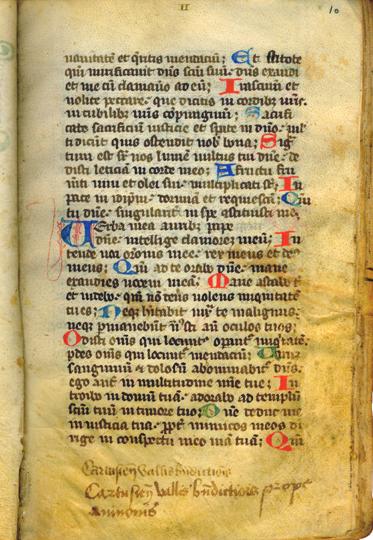 |

PROVENANCE
1. Made in southern France for use in a Carthusian milieu perhaps in the area
of Lyons or Grenoble (Blandina, martyr of Lyon in the litany; and Hugo, bishop of Grenoble, in the calendar), perhaps before
1333 (Thomas Aquinas added to the calendar, canonized in 1333). Script and decoration are consistent with a date in the opening
years of the fourteenth century.
2. Probably not long after its transcription still in the late fourteenth or
early fifteenth century, the manuscript was taken to and used in the celebrated Carthusian monastery of Villeneuve-lès-Avignon,
founded in 1356 by Pope Innocent IV, with their late medieval ownership inscriptions on f. 10r (the second page of the text):
Cartusiens vallis benedictionis and Carthusien vallis benedictionis prope avinonis (corresponding to the first type
of ex-libris from this foundation, that of the fourteenth and fifteenth centuries; see Forbin, p. 39, note 1). Adaptations
to the text of the manuscript were made when it was acquired by the monastery. The text of the dedication of the abbey is
correctly entered in the calendar on f. 4v under 19 August (as in Marseille, Bibl. Mun., MS 120, and other manuscripts). The
calendar has been adapted and graded for Carthusian use, and includes, for example, the Carthusian St. Hugh of Lincoln, with
12 readings (17 November), and the feast of relics on 8 November. St. Agricola, Bishop of Avignon is added on 2 September
with 3 readings. About 120 manuscripts survive from the once-great library of Villeneuve-lès-Avignon. In 1812, after the French
Revolution, the manuscripts were first transferred to the Hotel de Ville in Villeneuve, but they were afterwards sold en bloc
to the Montpellier bookseller, Felix Seguin, in November 1853 (see his catalogue, with a list of the manuscripts, most of
them liturgical). About half are in the Bibliothèque municipale de Marseille; Viellard, pp. 441-50; and Forbin, pp. 39-63).
Copyright © 2001-2020 Immaculate Heart of Mary Melbourne Hermitage
The Webmaster does not endorse, nor control, the advertisements appearing throughout this website.
|
